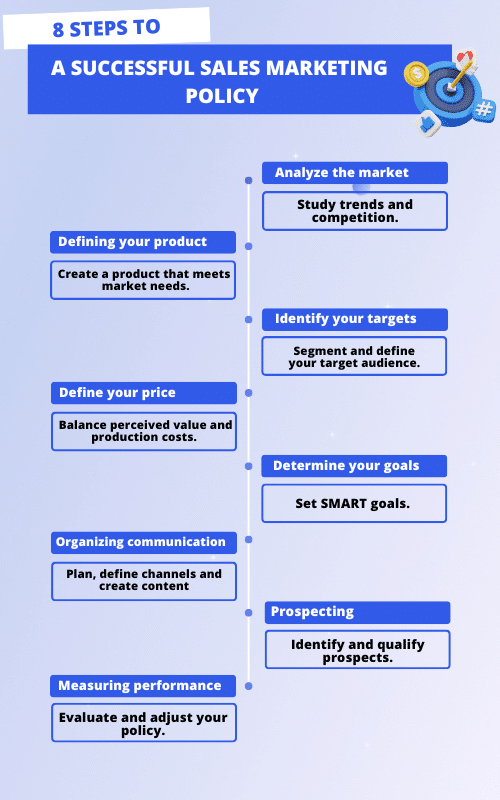What is a sales marketing policy? In this article, I’ll explain all its aspects, why it’s necessary for your business, and how it can help you achieve your objectives !
🔎 Before we get started, a point of definition is in order :
A sales marketing policy is the set of decisions taken in terms of distribution policy and pricing policy to achieve objectives.
All clear? Perfect! Let’s go and discover everything you need to know about trade policies! 🚀
What are the objectives of a sales marketing policy?
A sales marketing policy is an essential pillar for any company wishing to develop in a structured and efficient way. It encompasses all the strategies and actions put in place to achieve the desired sales objectives and market positioning. It includes aspects such as product selection, pricing, distribution and promotional techniques.
➡️ Its objectives may be to :
- ⭐️ Reinforce brand awareness and image: Improve consumer perception of the company.
- 📈 Increase sales and market share: Reach more customers and boost revenues.
- ❤️ Customer loyalty: Encourage buyers to return and recommend the company.
8 steps to setting up a sales marketing policy

1. Market analysis
To begin with, it’s crucial to carry out an in-depth study of your sector . This step will help you understand where your company stands and detect potential opportunities or threats. Here’s what you need to do:
- Identify current trends 📈: What’s new in your sector? What technologies are emerging?
- Study the environment 🌍 : Use PESTLE analysis to get a global view.
- Understand consumer needs 🛒: What are their desires, expectations and behaviors? Conduct quantitative and qualitative surveys.
Don’t know what questions to ask? We’ve got a dedicated article right here!
- Observe competitors’ actions 🕵️: Benchmark their tactics and identify opportunities or threats. What are their strengths and weaknesses? And adapt your sales planning accordingly.
This market study will provide you with a solid basis for implementing your “Smarketing” policy. You’ll better understand the dynamics of the sector, and be able to adapt your product or service accordingly.
2. Define your product
Once the analysis is complete, it’s time to (re)define your offer. This step is useful to ensure that you meet the needs identified during the analysis.
➡️ Here are 3 essential elements :
- Features 🛠️: What are the specific features of your product that meet consumer needs? Define key features.
- Design and development 🧩 Work on the creative side, rethinking product design and ergonomics. Make sure it’s attractive and intuitive.
- Continuous improvement 🔄: Gather consumer feedback to make improvements. Adapt your product based on customer feedback.
The aim of this stage is to create a product that stands out from the crowd. A well-defined product will enable you to position and sell it effectively. It’s important to remain flexible and continually adjust your offering to meet changing consumer expectations.
2. Identify your targets
Targeting the right segment is essential to an effective strategy. Here’s how:
- Segment the market 📊: Divide your prospects into homogeneous sub-groups according to criteria such as demographics, buying behavior, location…
- Create a buyer persona 👥: Develop typical profiles of your ideal prospects to better understand their needs and expectations. For example, imagine profiles with names, ages, professions, what apps they use, their interests…
- Tailor your marketing efforts 📣: Personalize your campaigns for each identified segment. Use appropriate messages and communication channels for each target.
Correctly targeting your sector maximizes the effectiveness of your marketing and sales actions . By understanding precisely who your targets are, you can better meet their expectations and improve their satisfaction. This in turn improves customer retention and loyalty. What’s more, you’ll achieve better overall performance.
4. Define your price
Your pricing strategy, i.e. the price you will charge in relation to the competition, must balance several factors to guarantee profitability while remaining competitive:
- Perceived value 💡: Pricing must reflect the value customers attribute to your product. That’s why you shouldn’t neglect annalysis.
- The cost of production 🏭: Make sure your tariff covers your costs and generates profits. Take into account both fixed and variable costs.
- Competition and positioning 📊: Analyze your competitors and adjust your positioning accordingly. Decide whether you want to be a cost leader (be the cheapest) or a differentiator .
- Sensitivity 💰: Test different pricing tactics to see how your target audience reacts. Use promotions or discounts to measure your buyers’ flexibility.
Setting the right price is crucial, as it influences product perception, profit margins and market competitiveness. A good pricing strategy can attract more prospects while maximizing revenues. By adjusting your pricing based on returns, you can strike the perfect balance between profitability and competitiveness.
5. Determine your goals
Setting clear, measurable objectives will guide your sales marketing policy towards success. They enable you to focus your efforts in the right places and measure your progress accurately.
➡️ But how do you define them? Here are our tips:
- SMART goals 📏 : Make sure every goal meets these criteria. With this method you can better plan, execute and adjust your tactics. For example, increase sales by 20% in six months.
- The short and the long term 🗓️: Set goals with different timeframes for a complete picture. Short-term goals can include quick wins, while long-term goals aim for sustainable growth.
- Alignment 🎯: Your objectives must be in line with your company’s mission and vision. They must also be consistent with your company’s available resources and capabilities.
6. Organizing communication
A well thought-out communication strategy is essential to reach your target audience and promote your product effectively.
➡️ To succeed in this step, here are three essential concepts:
- Channel selection 📬: Select the most relevant levers to reach your target audience, such as social networks, e-mailing, online advertising (SEA)…refer to your initial annalysis to observe where your target is present.
- Content creation 📝: Develop attractive content to capture your audience’s attention. You can use different formats such as blogs, real life, infographics… By creating relevant content, you maintain your customer relationships.
- Scheduling your posts 📅: Create an editorial schedule for the distribution of your posts, to help you get organized more easily. Find a rhythm that suits you, the primary goal being regularity.
7. Prospecting
Prospecting is essential to attracting new customers and generating sales. Here are the steps to follow:
- Identifying prospects 🔍: Use a variety of methods to identify potential buyers , such as social networks, trade shows, and referrals.
- Qualify prospects ✔️: Evaluate their potential to convert into paying customers. Use criteria such as need, budget and decision time.
- Follow-up and relationship 🤝: Maintain a regular relationship with your prospect right through to closing the sale. Use CRM tools, for example, to manage your contacts and interactions.
Prospecting maximizes the chances of converting a prospect into a buyer. By identifying the right prospects and maintaining a relationship, you can increase your conversion rates. Prospecting tools facilitate lead management and enable a more efficient and systematic approach. This step is crucial to your company’s continued growth.
To save time in your prospecting, you can automate it. All you need is the right tool. Our favorite? Waalaxy ! It’s designed to automate your LinkedIn and e-mail prospecting campaigns simply and efficiently.
8. Measuring performance
Evaluating the effectiveness of your sales performance is essential for adjusting your policy and guaranteeing long-term success. By measuring performance on a regular basis, you can quickly identify problems and opportunities. This enables you to make adjustments in real time.
Sales data analysis 📊: Compare results with targets . Examine trends and identify gaps to understand how your products are performing.
Customer feedback 🗣️: Collect and analyze feedback to understand their experiences and identify areas for improvement.
Campaign performance 📉 Evaluate what worked and what can be improved. Analyze key performance indicators (KPIs) such as conversion rate, return on investment (ROI), and engagement rate.
Necessary adjustments 🔄: Modify your tactics according to the results obtained for continuous improvement. Readjust your objectives, methods and resources to better meet industry expectations.
Now you have all the keys you need to successfully implement an effective sales marketing policy !
Frequently asked questions
Who’s in charge of sales marketing policy?
Sales marketing policy is essential to any company. It requires coordination between various departments to ensure its success. Although the main responsibility may lie with the sales manager or the marketing director. It is multidisciplinary. Ainis, several key players contribute to it:
- Sales manager : Plays a key role in defining the company’s sales strategies and overall business objectives . He oversees the implementation of sales marketing policy and its alignment with corporate objectives.🎯
- Marketing Director: Deals with all aspects of product positioning, promotion and communication. Operational marketing plays an essential role in developing those aspects of sales marketing policy that directly affect consumers.👥
- Production team: Ensures that products are designed and manufactured in line with objectives, taking into account market feedback and costs.⭐️
- Financial department : Involved in setting prices and managing marketing and sales budgets, ensuring that sales marketing policy is financially viable.💰
- Customer service : Provides essential feedback on prospects’ expectations and satisfaction, enabling you to improve continuously.📈
The effectiveness of sales marketing policy therefore depends on the relationship between the various departments, enabling the company to respond agilely to change. Agile project management methods need to be put in place to organize the allocation of tasks and the monitoring of objectives.
What’s the difference between sales marketing policy and commercial policy?
It’s normal to confuse sales marketing policy and marketing policy. They are similar in some respects, yet they have slightly different aspects:

In short, sales marketing policy defines the “what” and “why” of market activities, while sales policy deals with the “how”. Effective sales marketing policy ensures that all aspects of strategy are aligned with the company’s overall vision, while sales policy focuses on maximizing revenue through effective sales techniques . These two policies must work together to guarantee a company’s commercial success.












